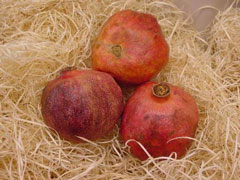


Home
Flowers &
Indoor Plants
Fruits & Nuts
Ornamentals
Vegetables
Special Topics
Resources
Glossary

|
Pomegranate Punica granatum (pew-nick-ah grah-nah-tum)    Click on thumbnails for larger image. |
 |
What about it? Like the persimmon, the pomegranate is enjoyed for its many ornamental qualities, as well as for its unusual fruit. This plant usually suffers from freezing injury at temperatures much below 20 degrees F. Pomegranates are deciduous shrubs or small trees with long, narrow light-green leaves that turn a clear yellow in the fall. The flowers are a very showy orange-red, while the fruits are large, round and filled with seeds. The seeds are covered with a red material. The pomegranate has enjoyed a place in religious symbolism and in art. What is it used for? When mature, the pomegranate is roughly the size of an orange. The pulpy red material surrounding the seeds, and the seeds themselves are edible. A juice can be made from the pulp; this juice is also used in jellies. This small, pendulous tree is greatly enjoyed for its many ornamental qualities, and can be containerized or espaliered. Where does it grow? How do we grow it? The pomegranate is tolerant of cold weather, but temperatures much below 20 degrees F will damage the tree. For fruit production, a hot and dry climate is best. The pomegranate is not difficult to grow, and responds nicely to pruning. Like the peach, the pomegranate fruits on new wood, and will thus fruit even in years of heavier-than-usual pruning. Gardeners who grow the pomegranate as a tree will need to remove suckers each year. The pomegranate tolerates a range of soil types but should have good drainage. What are its primary problems?Fruit rot can be a problem with pomegranates. How do we harvest and store it? The fruits will ripen about 6 months after bloom. Pomegranates are harvested when the fruits turn reddish. A slight squeeze of the ripe fruit will give a crackling sound; if fruits are allowed to remain on the tree until they are fully ripe, they are likely to split open. If stored in a cool, dry place, the pomegranates will keep for several months. Although the rind may shrink, the pulp actually becomes sweeter and the seeds softer.
© Copyright, Department of Horticulture, Cornell University. |